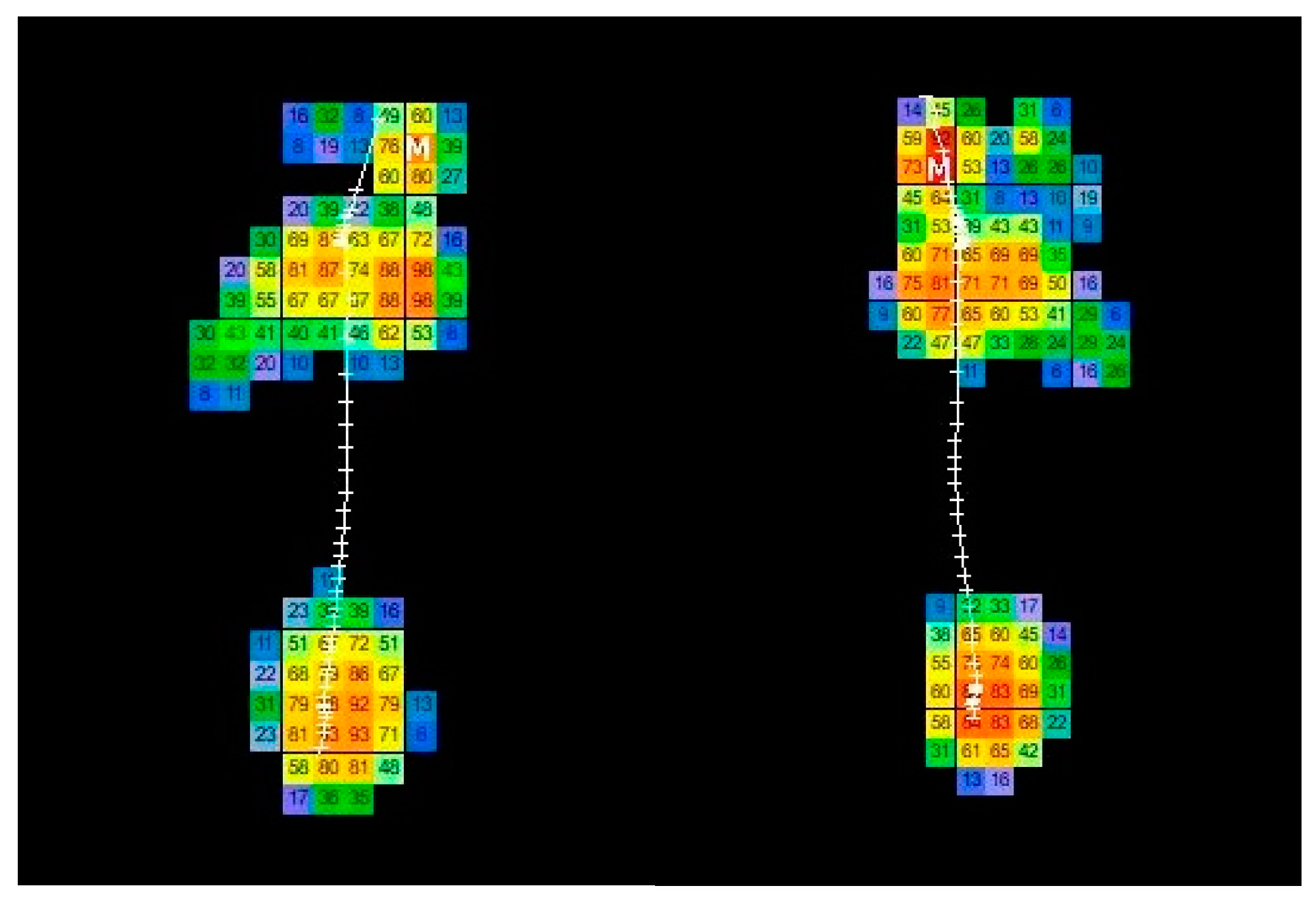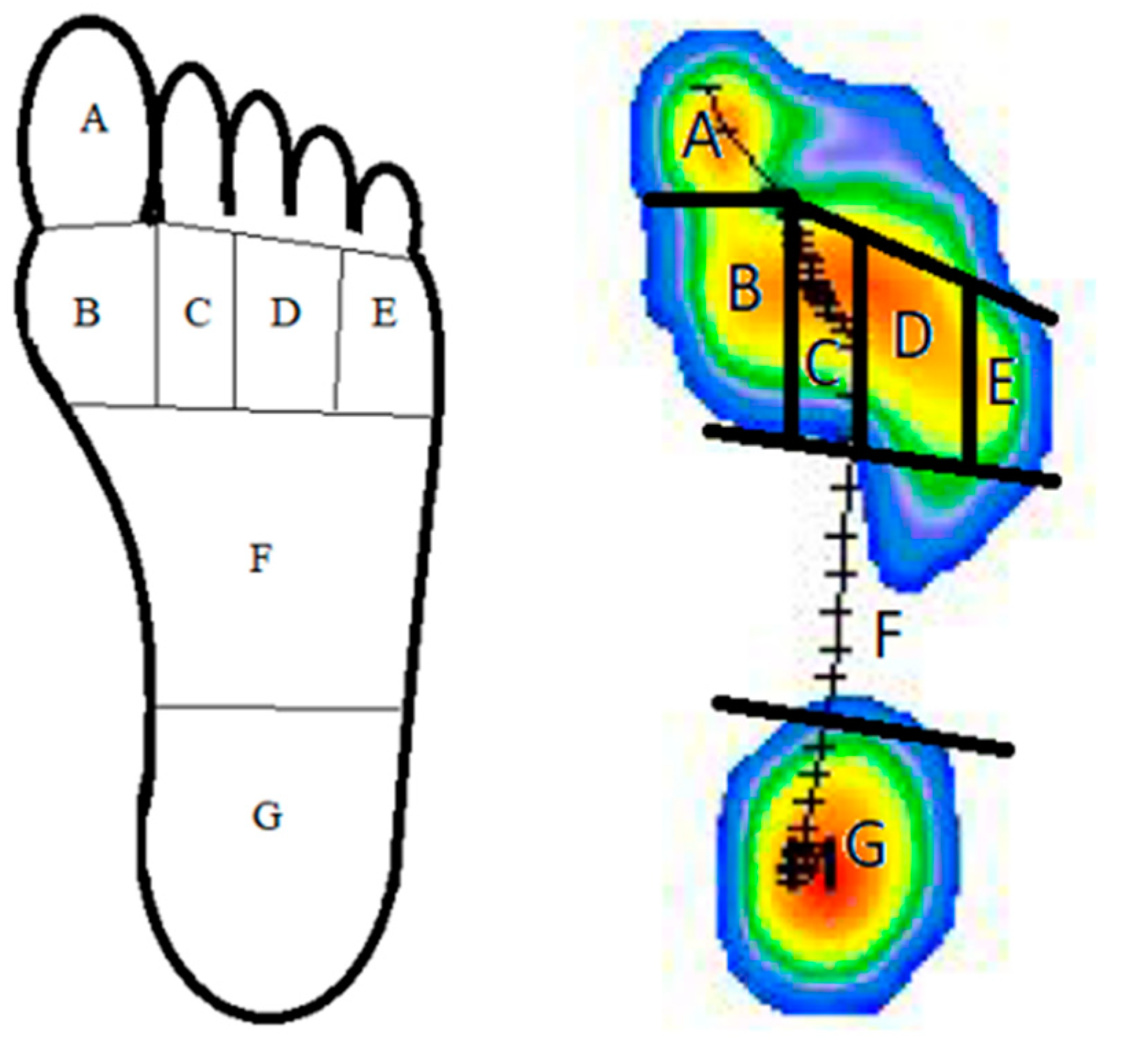Hallux Limitus Influence on Plantar Pressure Variations during the Gait Cycle: A Case-Control Study
Abstract
1. Introduction
2. Material and Methods
2.1. Study Design
2.2. Sociodemographic Data
2.3. Procedure
2.4. Statistical Analysis
3. Results
Measured Data’s Principal Outcomes
4. Discussion
5. Conclusions
Author Contributions
Funding
Institutional Review Board Statement
Informed Consent Statement
Data Availability Statement
Conflicts of Interest
References
- Viehöfer, A.F.; Vich, M.; Wirth, S.H.; Espinosa, N.; Camenzind, R.S. The Role of Plantar Fascia Tightness in Hallux Limitus: A Biomechanical Analysis. J. Foot Ankle Surg. 2019, 58, 465–469. [Google Scholar] [CrossRef]
- Camasta, C.A. Hallux limitus and hallux rigidus: Clinical examination, radiographic findings, and natural history. Clin. Podiatr. Med. Surg. 1996, 13, 423–448. [Google Scholar] [PubMed]
- Clough, J.G. Functional hallux limitus and lesser-metatarsal overload. J. Am. Podiatr. Med. Assoc. 2005, 95, 593–601. [Google Scholar] [CrossRef] [PubMed]
- Menz, H.B.; Auhl, M.; Tan, J.M.; Buldt, A.K.; Munteanu, S.E. Centre of pressure characteristics during walking in individuals with and without first metatarsophalangeal joint osteoarthritis. Gait Posture 2018, 63, 91–96. [Google Scholar] [CrossRef]
- Meyr, A.J.; Berkelbach, C.; Dreikorn, C.; Arena, T. Descriptive Quantitative Analysis of First Metatarsal Sagittal Plane Motion. J. Foot Ankle Surg. 2020, 59, 1244–1247. [Google Scholar] [CrossRef]
- Padrón, L.; Bayod, J.; Becerro-de-Bengoa-Vallejo, R.; Losa-Iglesias, M.; López-López, D.; Casado-Hernández, I. Influence of the center of pressure on baropodometric gait pattern variations in the adult population with flatfoot: A case-control study. Front. Bioeng. Biotechnol. 2023, 11, 1147616. [Google Scholar] [CrossRef]
- Hall, C.; Nester, C.J. Sagittal plane compensations for artificially induced limitation of the first metatarsophalangeal joint: A preliminary study. J. Am. Podiatr. Med. Assoc. 2004, 94, 269–274. [Google Scholar] [CrossRef]
- Scherer, P.R.; Sanders, J.; Eldredge, D.E.; Duffy, S.J.; Lee, R.Y. Effect of functional foot orthoses on first metatarsophalangeal joint dorsiflexion in stance and gait. J. Am. Podiatr. Med. Assoc. 2006, 96, 474–481. [Google Scholar] [CrossRef]
- Van Gheluwe, B.; Dananberg, H.J.; Hagman, F.; Vanstaen, K. Effects of hallux limitus on plantar foot pressure and foot kinematics during walking. J. Am. Podiatr. Med. Assoc. 2006, 96, 428–436. [Google Scholar] [CrossRef]
- Vallotton, J. Functional hallux limitus or rigidus caused by a tenodesis effect at the retrotalar pulley: Description of the functional stretch test and the simple hoover cord maneuver that releases this tenodesis. J. Am. Podiatr. Med. Assoc. 2010, 100, 220–229. [Google Scholar]
- Smith, C.; Spooner, S.K.; Fletton, J.A. The effect of 5-degree valgus and varus rearfoot wedging on peak hallux dorsiflexion during gait. J. Am. Podiatr. Med. Assoc. 2004, 94, 558–564. [Google Scholar] [CrossRef] [PubMed]
- Dananberg, H.J. Gait style as an etiology to chronic postural pain. Part II. Postural compensatory process. J. Am. Podiatr. Med. Assoc. 1993, 83, 615–624. [Google Scholar] [PubMed]
- Durrant, B.; Chockalingam, N. Functional hallux limitus: A review. J. Am. Podiatr. Med. Assoc. 2009, 99, 236–243. [Google Scholar] [CrossRef]
- Harradine, P.; Bevan, L.; Carter, N. An overview of podiatric biomechanics theory and its relation to selected gait dysfunction. Physiotherapy 2006, 92, 122–127. [Google Scholar] [CrossRef]
- Menz, H.B.; Dufour, A.B.; Riskowski, J.L.; Hillstrom, H.J.; Hannan, M.T. Foot posture, foot function and low back pain: The Framingham Foot Study. Rheumatology 2013, 52, 2275. [Google Scholar] [CrossRef]
- Bryant, A.; Tinley, P.; Singer, K. Plantar pressure distribution in normal, hallux valgus and hallux limitus feet. Foot 1999, 9, 115–119. [Google Scholar] [CrossRef]
- Cuschieri, S. The STROBE guidelines. Saudi J. Anaesth. 2019, 13, S31–S34. [Google Scholar] [CrossRef]
- Holt, G.R. Declaration of Helsinki-the world’s document of conscience and responsibility. South. Med. J. 2014, 107, 407. [Google Scholar] [CrossRef]
- Becerro-de-Bengoa-Vallejo, R.; Losa-Iglesias, M.E.; Rodriguez-Sanz, D. Static and dynamic plantar pressures in children with and without sever disease: A case-control study. Phys. Ther. 2014, 94, 818–826. [Google Scholar] [CrossRef]
- Ito, T.; Noritake, K.; Ito, Y.; Tomita, H.; Mizusawa, J.; Sugiura, H.; Matsunaga, N.; Ochi, N.; Sugiura, H. Three-dimensional gait analysis of lower extremity gait parameters in Japanese children aged 6 to 12 years. Sci. Rep. 2022, 12, 7822. [Google Scholar] [CrossRef]
- Daunoraviciene, K.; Ziziene, J. Accuracy of Ground Reaction Force and Muscle Activation Prediction in a Child-Adapted Musculoskeletal Model. Sensors 2022, 22, 7825. [Google Scholar] [CrossRef] [PubMed]
- Gibson, M.; Stork, N. Gait Disorders. Prim Care 2021, 48, 395–415. [Google Scholar] [CrossRef] [PubMed]
- Samson, W.; Van Hamme, A.; Desroches, G.; Dohin, B.; Dumas, R.; Chèze, L. Biomechanical maturation of joint dynamics during early childhood: Updated conclusions. J. Biomech. 2013, 46, 2258–2263. [Google Scholar] [CrossRef]
- Findlow, A.H.; Nester, C.J.; Bowker, P. Foot kinematics in patients with two patterns of pathological plantar hyperkeratosis. J. Foot Ankle Res. 2011, 4, 7. [Google Scholar] [CrossRef] [PubMed]
- Bojsen-Møller, F. Calcaneocuboid joint and stability of the longitudinal arch of the foot at high and low gear push off. J. Anat. 1979, 129, 165–176. [Google Scholar] [PubMed]
- Roukis, T.S.; Scherer, P.R.; Anderson, C.F. Position of the first ray and motion of the first metatarsophalangeal joint. J. Am. Podiatr. Med. Assoc. 1996, 86, 538–546. [Google Scholar] [CrossRef]
- Visscher, R.M.S.; Sansgiri, S.; Freslier, M.; Harlaar, J.; Brunner, R.; Taylor, W.R.; Singh, N.B. Towards validation and standardization of automatic gait event identification algorithms for use in paediatric pathological populations. Gait Posture 2021, 86, 64–69. [Google Scholar] [CrossRef]
- Agostini, V.; Nascimbeni, A.; Di Nardo, F.; Fioretti, S.; Burattini, L.; Knaflitz, M. Dependence of gait parameters on height in typically developing children. In Proceedings of the 2015 37th Annual International Conference of the IEEE Engineering in Medicine and Biology Society (EMBC), Milan, Italy, 25–29 August 2015; pp. 7598–7601. [Google Scholar]
- Beurskens, R.; Muehlbauer, T.; Granacher, U. Association of dual-task walking performance and leg muscle quality in healthy children. BMC Pediatr. 2015, 15, 2. [Google Scholar] [CrossRef]


| Sample Characteristics | Total Group (n = 100) Mean ± SD (Range) | HL (n = 50) Mean ± SD (Range) | Healthy (n = 50) Mean ± SD (Range) | p-Value |
|---|---|---|---|---|
| Age (years) | 9.62 ± 1.37 (7–12) | 9.68 ± 1.29 (7–12) | 9.56 ± 1.46 (7–12) | 0.607 † |
| Weight (kg) | 37.84 ± 11.04 (20.50–90.00) | 37.12 ± 8.53 (23.30–56.60) | 38.57 ± 13.13 (20.50–90.00) | 0.809 † |
| Height (cm) | 140.37 ± 10.75 (118.0–176.00) | 140.10 ± 9.54 (121.00–167.00) | 140.64 ± 11.92 (118.00–176.00) | 0.885 † |
| BMI (kg/m2) | 18.83 ± 3.68 (11.00–40.00) | 18.64 ± 2.68 (14.00–25.00) | 19.02 ± 4.48 (11.00–40.00) | 0.803 † |
| Sex (male/female) | 50/50 (50.0/50.0) | 22/28 (44.0/56.0) | 28/22 (56.0/44.0) | 0.317 ‡ |
| Foot size | 35.99 ± 2.67 (28.00–43.0) | 36.09 ± 2.20 (31.0–43.0) | 35.88 ± 3.08 (28.00–42.0) | 0.665 † |
| Variables | Total Group (n = 100) Mean ± SD (Range) | HL (n = 50) Mean ± SD (Range) | Healthy (n = 50) Mean ± SD (Range) | p-Value |
|---|---|---|---|---|
| Left surface area (cm2) | 88.59 ± 19.63 (37–141) | 89.54 ± 18.12 (51–127) | 87.64 ± 21.17 (37–141) | 0.634 † |
| Right surface area (cm2) | 89.72 ± 19.99 (29–135) | 90.38 ± 19.58 (44–125) | 89.06.11 ± 20.57 (29–135) | 0.796 † |
| Left maximum peak pressure (kPa) | 1792.72 ± 479.28 (17.0–3566.0) | 1789.92 ± 308.41 (1160–2503) | 1795.51 ± 307.43 (17–3566) | 0.751 † |
| Right maximum peak pressure (kPa) | 1757.88 ± 482.93 (12–3854) | 1759.10 ± 366.86 (262–2616) | 1756.66 ± 580.19 (12–64) | 0.697 † |
| Left average peak pressure (kPa) | 1089.47 ± 862.36 (46–9310) | 1162.89 ± 1188.17 (716–9310) | 1016.06 ± 282.42 (46–1945) | 0.560 † |
| Right average peak pressure (kPa) | 1000.88 ± 237.94 (24–1906) | 1002.08 ± 180.93 (683–1516) | 999.69 ± 285.74 (24–1906) | 0.890 † |
| Body weight in hallux (left/right) (%) | 11/14 (11.0/14.0) | 10/8 (20.0/16.0) | 1/6 (2.0/12.0) | 0.127 ‡ |
| Body weight in first metatarsal head (left/right) (%) | 9/7 (9.0/7.0) | 8/5 (16.0/10.0) | 1/2 (2.0/4.00) | 0.354 ‡ |
| Body weight in second metatarsal head (left/right) (%) | 11/23 (11.0/23.0) | 4/12 (8.0/24.0) | 7/11 (14.0/22.0) | 0.156 ‡ |
| Body weight in third & fourth metatarsal heads (left/right) (%) | 37/22 (37.0/22.0) | 11/7 (22.0/14.0) | 26/15 (52.0/30.0) | 0.031 ‡ |
| Body weight in fifth metatarsal head (left/right) (%) | 1/1 (1.0/1.0) | 0/0 (0.0/0.00) | 1/2 (2.0/4.00) | 1.325 ‡ |
| Body weight in midfoot (left/right) (%) | 0/1 (0.0/1.0) | 0/0 (0.00/0.00) | 0/1 (0.00/2.00) | 1.432 ‡ |
| Body weight in heel (left/right) (%) | 31/31 (31.0/31.0) | 17/18 (34.0/36.0) | 14/13 (28.0/26.0) | 0.023 ‡ |
Disclaimer/Publisher’s Note: The statements, opinions and data contained in all publications are solely those of the individual author(s) and contributor(s) and not of MDPI and/or the editor(s). MDPI and/or the editor(s) disclaim responsibility for any injury to people or property resulting from any ideas, methods, instructions or products referred to in the content. |
© 2023 by the authors. Licensee MDPI, Basel, Switzerland. This article is an open access article distributed under the terms and conditions of the Creative Commons Attribution (CC BY) license (https://creativecommons.org/licenses/by/4.0/).
Share and Cite
Cuevas-Martínez, C.; Becerro-de-Bengoa-Vallejo, R.; Losa-Iglesias, M.E.; Casado-Hernández, I.; Navarro-Flores, E.; Pérez-Palma, L.; Martiniano, J.; Gómez-Salgado, J.; López-López, D. Hallux Limitus Influence on Plantar Pressure Variations during the Gait Cycle: A Case-Control Study. Bioengineering 2023, 10, 772. https://doi.org/10.3390/bioengineering10070772
Cuevas-Martínez C, Becerro-de-Bengoa-Vallejo R, Losa-Iglesias ME, Casado-Hernández I, Navarro-Flores E, Pérez-Palma L, Martiniano J, Gómez-Salgado J, López-López D. Hallux Limitus Influence on Plantar Pressure Variations during the Gait Cycle: A Case-Control Study. Bioengineering. 2023; 10(7):772. https://doi.org/10.3390/bioengineering10070772
Chicago/Turabian StyleCuevas-Martínez, Claudia, Ricardo Becerro-de-Bengoa-Vallejo, Marta Elena Losa-Iglesias, Israel Casado-Hernández, Emmanuel Navarro-Flores, Laura Pérez-Palma, João Martiniano, Juan Gómez-Salgado, and Daniel López-López. 2023. "Hallux Limitus Influence on Plantar Pressure Variations during the Gait Cycle: A Case-Control Study" Bioengineering 10, no. 7: 772. https://doi.org/10.3390/bioengineering10070772
APA StyleCuevas-Martínez, C., Becerro-de-Bengoa-Vallejo, R., Losa-Iglesias, M. E., Casado-Hernández, I., Navarro-Flores, E., Pérez-Palma, L., Martiniano, J., Gómez-Salgado, J., & López-López, D. (2023). Hallux Limitus Influence on Plantar Pressure Variations during the Gait Cycle: A Case-Control Study. Bioengineering, 10(7), 772. https://doi.org/10.3390/bioengineering10070772













